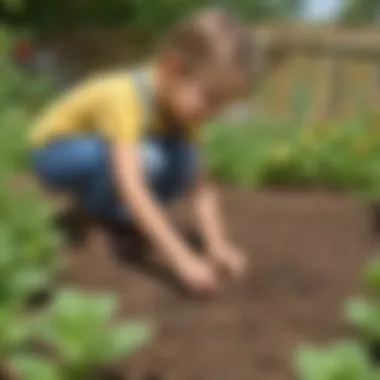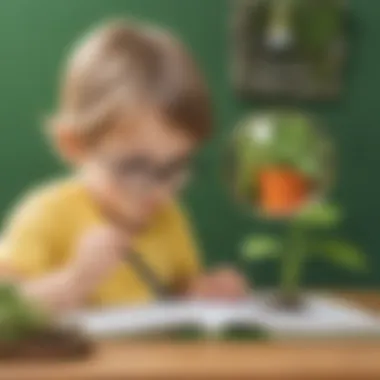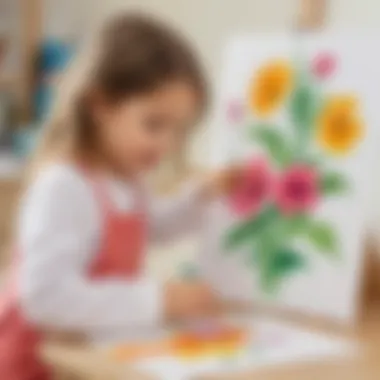Engaging Plant Lesson Plans for Preschoolers: Cultivating Curiosity and Learning


Science Fun Facts
Plant life is full of wonders and mysteries waiting to be uncovered by curious minds. Did you know that some plants can live for hundreds of years, adding wisdom and history to our natural surroundings? Understanding how plants grow and thrive can lead to a deeper appreciation of the environment. While plants may seem static, they are constantly communicating and interacting with the world around them, showcasing the beauty of interconnected ecosystems.
Discover the Wonders of Science
Exploring the wonders of plant life can be an enriching experience for preschoolers. By observing the growth patterns of different plants, children can learn about photosynthesis, the process by which plants convert sunlight into energy. Educational videos and animations can visually demonstrate these concepts, making learning both fun and informative. Interactive learning tools help children engage with plant anatomy and understand the importance of plants in our daily lives.
Science Quiz Time
Now, let's put your newfound knowledge to the test with some fun and interactive plant quizzes! What part of the plant is responsible for absorbing water and nutrients? A) Roots B) Leaves C) Stem. Plant-themed multiple-choice questions are a great way to reinforce learning and challenge young minds. Brain teasers and puzzles centered around plants can enhance critical thinking skills while gamification makes learning exciting and engaging.
Science Experiment Showcase
Embark on a journey of scientific discovery with hands-on plant experiments. Witness the magic of germination by planting seeds and observing their growth over time. Follow step-by-step instructions to create a mini greenhouse and learn firsthand about the conditions plants need to thrive. A materials list will guide you in gathering everything you need, while safety tips ensure a secure and enjoyable experiment for all participants. Get ready to explore the science of plants in a fun and interactive way!
Introduction
Importance of Plant Education
Benefits of Early Plant Learning
Early exposure to plant learning offers a myriad of advantages for preschoolers. It aids in enhancing their cognitive skills, fostering a sense of empathy towards nature, and instilling a curiosity-driven approach to learning. By engaging with plants from a young age, children develop a profound appreciation for the environment, promoting sustainable practices in the future. The unique feature of Benefits of Early Plant Learning lies in its ability to create a strong foundation for ecological awareness and scientific curiosity, making it a valuable choice for this article.
Encouraging Environmental Awareness
Encouraging environmental awareness through plant education instills a sense of responsibility and stewardship in preschoolers. It sensitizes them to the importance of conservation, biodiversity, and the delicate balance in nature. By intertwining concepts of plant life with environmental consciousness, children learn to appreciate and respect the ecosystem they are a part of. The distinct feature of Encouraging Environmental Awareness lies in its capacity to nurture a generation of environmentally conscious individuals, a pivotal aspect for sustained ecological health.


Target Audience
Preschoolers' Learning Needs
Understanding and catering to the unique learning needs of preschoolers is fundamental in developing effective plant lesson plans. Preschoolers thrive on hands-on experiences, sensory engagement, and visual aids. Their inquisitive nature and burgeoning curiosity necessitate interactive and stimulating methods of teaching. By aligning lesson content with their developmental milestones, educators can create impactful learning experiences that resonate with young children. The exceptional feature of Preschoolers' Learning Needs is its focus on tailored strategies that cater to the specific requirements of this age group, making it a crucial element in this article.
Engagement Techniques
Implementing engaging techniques ensures active participation and retention among preschoolers. Incorporating play-based learning, sensory activities, and interactive experiments captivates young learners and facilitates a deeper understanding of plant concepts. By making learning fun and engaging, educators can sustain children's interest and curiosity throughout the educational process. The distinguishing characteristic of Engagement Techniques is their ability to create a dynamic and participatory learning environment, enhancing the overall educational experience for preschoolers.
Interactive Plant Activities
Interactive plant activities play a pivotal role in boosting preschoolers' engagement with nature. Teaching young children the various aspects of plants through interactive activities not only enhances their cognitive development but also instills a sense of curiosity and wonder about the natural world. These activities enable children to explore plant parts such as roots, stems, and leaves through hands-on experiences, fostering a deeper understanding of the botanical world. By immersing children in interactive plant activities, educators can create a dynamic and stimulating learning environment that sparks enthusiasm for learning.
Exploring Plant Parts
Roots, Stems, Leaves
Digging into the fascinating world of plant parts, focusing on roots, stems, and leaves, allows preschoolers to comprehend the essential roles these components play in plant growth and vitality. Roots anchor the plant in the soil and absorb water and nutrients, while stems provide structure and transport water and nutrients throughout the plant. Leaves are the powerhouses of photosynthesis, converting sunlight into energy for the plant's growth. Understanding these key plant parts lays a robust foundation for preschoolers' botanical knowledge, nurturing their curiosity about plant biology.
Hands-On Identification Activities
Engaging preschoolers in hands-on identification activities not only reinforces their learning about plant parts but also cultivates their observational skills and critical thinking abilities. By touching, feeling, and observing different plant parts up close, children develop a tactile understanding of the unique features of roots, stems, and leaves. These hands-on activities create memorable learning experiences that leave a lasting impact on preschoolers, enhancing their overall engagement and retention of plant-related knowledge.
Life Cycle Lessons
Seeding to Germination
Exploring the life cycle of plants from seeding to germination exposes preschoolers to the wonders of natural growth processes. Witnessing the transformation of a tiny seed into a sprouting plant instills a sense of awe and appreciation for the magic of life cycles. Learning about the conditions required for successful germination and the care needed for young plants to thrive instills responsibility and nurtures preschoolers' connection to the natural world.


Craft-Based Projects
Craft-based projects that focus on plant life cycles not only nurture preschoolers' creativity but also reinforce their understanding of plant development stages. By engaging in hands-on crafting activities such as seed collages or plant growth journals, children internalize the sequential nature of plant growth while honing their fine motor skills. These projects offer a multidimensional learning experience that combines artistry with scientific exploration, making learning about plant life cycles both entertaining and educational.
Plant Growth Experiments
Observing Growth Patterns
Encouraging preschoolers to observe and document plant growth patterns empowers them to become budding botanists. By tracking the growth of plants over time, children develop a keen eye for detail and an appreciation for the gradual changes that occur in living organisms. Observing growth patterns not only sharpens children's scientific inquiry skills but also teaches them the importance of patience and perseverance in understanding the complexities of nature.
Nutrient and Light Importance
Highlighting the significance of nutrients and light in plant growth through hands-on experiments immerses preschoolers in the fundamentals of botany. By experimenting with varying nutrient levels and light exposure on plant growth, children grasp the essential role these factors play in shaping plant development. Understanding the interplay between nutrients and light equips preschoolers with a foundational knowledge of plant requirements, fostering a holistic understanding of the delicate balance needed for healthy plant growth.
Educational Resources
Importance of Educational Resources
In the realm of preschool plant education, the utilization of educational resources plays a pivotal role in enhancing children's understanding and engagement. Educational resources encompass a wide array of tools and materials that aim to enrich the learning experience, making it more interactive, stimulating, and effective. By incorporating diverse educational resources, educators can cater to various learning styles and preferences, promoting a holistic approach to plant education. These resources not only facilitate knowledge acquisition but also nurture curiosity, creativity, and critical thinking skills in preschoolers, laying a solid foundation for their future learning journey.
Books and Online Tools
When delving into the world of educational resources for preschool plant education, books and online tools emerge as indispensable assets. Interactive Plant Books, specifically tailored for young learners, offer a dynamic way to introduce plant concepts through engaging visuals, interactive elements, and age-appropriate explanations. These books not only enhance children's comprehension but also foster a sense of wonder and exploration, making learning a fun-filled adventure. On the other hand, Online Plant Learning Websites provide a virtual platform for immersive plant education, combining informative content with interactive activities to create a comprehensive learning experience. With easy accessibility and interactive features, online tools contribute significantly to enriching preschoolers' learning journey, making plant education exciting and accessible.
Printable Worksheets
In the landscape of preschool plant education, printable worksheets stand out as versatile tools for reinforcing learning concepts and encouraging hands-on engagement. Coloring Pages offer a creative outlet for children to express their understanding of plant life through vibrant illustrations and design activities. These pages not only stimulate artistic expression but also reinforce plant identification skills, making learning enjoyable and memorable. On the other hand, Matching Activities provide a cognitive challenge by encouraging children to associate plant-related images, words, or concepts, promoting memory retention and critical thinking. Through interactive and visually appealing worksheets like Matching Activities, preschoolers can enhance their cognitive skills, observational abilities, and attention to detail, enriching their plant learning experience.


Incorporating Nature in Learning
In this section of the article, we delve into the crucial concept of incorporating nature in learning, particularly focusing on preschool education. Included within this theme are the fundamental aspects, benefits, and considerations regarding the integration of nature-based activities in educational settings. Recognizing the intrinsic connection between children and the natural world, incorporating nature in learning serves as a catalyst for holistic development. By immersing preschoolers in outdoor experiences, educators can foster a deeper appreciation for the environment and instill a sense of stewardship from a tender age. Furthermore, integrating nature into learning environments has been shown to enhance cognitive abilities, promote physical well-being, and nurture creativity in young learners. Through this exploration, we aim to shed light on the significance of embracing nature as a central component of early education.
Outdoor Exploration
Nature Walks
Nature walks offer a dynamic way to engage preschoolers with the natural world, allowing them to explore and discover its wonders firsthand. These walks in natural settings provide children with sensory-rich experiences, fostering an intimate connection with the environment. The key characteristic of nature walks lies in their ability to stimulate curiosity and ignite a sense of wonder in young minds. By encouraging children to observe, touch, and interact with the elements of nature, nature walks promote experiential learning and sensory development. Despite some logistical challenges, such as weather contingencies, the benefits of nature walks in this educational context far outweigh the obstacles, making them a popular and enriching choice for educators.
Gardening Activities
Gardening activities play a pivotal role in merging learning with hands-on experience, offering preschoolers a unique opportunity to witness the lifecycle of plants up close. The key characteristic of gardening activities is their practical approach to understanding botanical processes, from planting seeds to nurturing growth. By engaging children in gardening, educators can cultivate patience, responsibility, and environmental awareness. One notable advantage of gardening activities is their adaptability to various educational objectives, making them a versatile and effective tool for experiential learning. While some challenges may arise, such as space constraints or time commitments, the benefits of incorporating gardening into preschool curricula far surpass the limitations, making it a valuable choice for educators seeking to enrich young minds.
Nature-Inspired Arts
Leaf Painting
Leaf painting is a creative activity that infuses art with elements of nature, allowing children to explore textures, shapes, and colors found in the environment. The distinctive feature of leaf painting lies in its ability to blend artistic expression with natural inspiration, encouraging children to create unique masterpieces using leaves as their canvas. This activity not only stimulates imagination and creativity but also instills a sense of appreciation for the beauty of the natural world. The advantages of leaf painting in educational settings are manifold, including enhancing fine motor skills, honing observational abilities, and fostering a deep connection with nature. While certain challenges may arise, such as leaf availability or messiness, the benefits of incorporating leaf painting into preschool art activities make it a valuable and engaging choice for educators.
Plant Collages
Plant collages offer preschoolers a hands-on way to explore nature's diversity and express their creativity through artistic composition. The key characteristic of plant collages is their capacity to transform natural elements into artworks, fostering children's aesthetic sensibilities and imaginative skills. By arranging leaves, flowers, and other plant parts into collages, young learners can not only develop their artistic abilities but also gain a deeper understanding of botanical diversity. The unique feature of plant collages lies in their ability to bridge art and science, inspiring children to see nature from a new perspective. While challenges such as material availability or allergies may arise, the benefits of creating plant collages as part of a nature-inspired curriculum outweigh the potential obstacles, making it a rewarding choice for educators aiming to enrich children's artistic and scientific literacy.
Conclusion
Fostering Plant Curiosity
Encouraging Lifelong Learning:
Exploring the facet of Encouraging Lifelong Learning in the realm of plant education is crucial. By promoting a continuous pursuit of knowledge and exploration, we empower children to develop critical thinking skills and a growth mindset. The key characteristic of Encouraging Lifelong Learning lies in its ability to fuel intellectual curiosity and a passion for discovery. This approach is deemed invaluable for cultivating a thirst for knowledge among young learners. However, it is essential to balance structured learning with allowing for self-discovery to harness the full potential of Encouraging Lifelong Learning within this article.
Plant Education Impact:
Delving into the impact of plant education on young minds unveils a realm of possibilities. The key characteristic of Plant Education Impact lies in its potential to nurture environmental consciousness and a sense of responsibility towards the ecosystem. By highlighting the interconnectedness between plants, humans, and the environment, children can grasp the importance of conservation and sustainability. This unique feature of Plant Education Impact serves as a catalyst for instilling values of respect and stewardship for the natural world among preschoolers within the context of this article.







